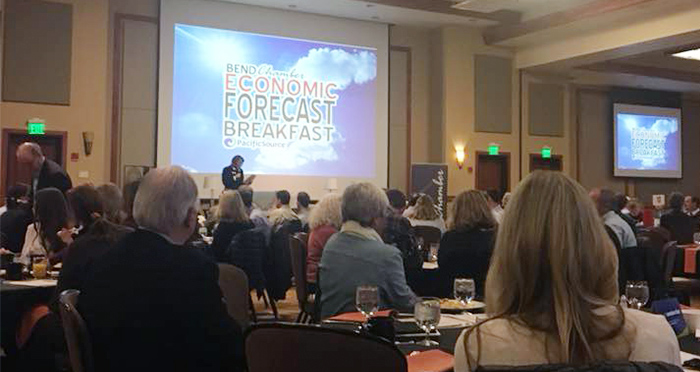(Photo by Simon Mather)
2017 Forecast Breakfast Looks at Region’s Achievements and Challenges
“From Great Recession to Grand Recovery” is how State Economist Damon Runberg – one of the expert panelists addressing Bend Chamber’s annual Economic Forecast Breakfast for 2017 – described the Bend-metro area’s remarkable turnaround from downturn to economic powerhouse with the second-highest rate of job growth in the nation.
Chamber President Katy Brooks introduced an impressive trio of speakers to the packed house of attendees at Bend’s Riverhouse Convention Center, including Oregon Employment Department State Economist Runberg, leading small business analyst Paynet’s Senior Economist Mark Zoff, and Urban3, LLC consultants Principal Joe Minicozzi, who provided specialist insight into local and national indicators.
Runberg posed the question of whether some of the undoubtedly impressive economic gains achieved in Central Oregon had plateaued or could be sustainable into the future, and used the analogy of how a concept termed “the aggregation of marginal gains” employed by professional cycling’s Team Sky took them from perennial contenders to multiple Tour de France championships.
Runberg said: “The team manager instilled the philosophy that there is a one per cent margin for improvement in anything we do. Sky had the same general level of riders and budget as other teams, but didn’t get to the highest level until they focused on the finest of details regarding how to improve performance – even down to the best type of massage gel to use for their cyclists.
“Similarly with the Bend area, you may ask if this is as good as it gets, given that employment trends since 2007 exceeded their pre-recession peak two-and-a-half years ago and continued to expand since, to the point where we set the second fastest pace in terms of job growth out of 350 comparable metro markets across the US, with an unemployment rate at or near historic lows. To that I would say, forget about perfection but compound improvements.
“The region’s Gross Domestic Product output as a barometer of the economy is 22 per cent higher than the last peak and some 40 per cent higher than 2010, but though tourism has a consistent impact, it is encouraging to note that the main drivers of recent growth have not come from some banner industry, but across a more diverse variety of sectors, including the financial sector, professional services and manufacturing.”
Runberg said indicators did not lead him to foresee a recession in the near future, and home prices locally had recovered to pre-recession levels though affordability issues remained, and postulated that now could be a good time to take a pause and ponder how to progress from what could be perceived as an economic peak and analyze areas where gains could be maintained.
He added: “I would focus on retaining and expanding the labor pool. In the downturn you might have 10 or 11 candidates per job on average; which represented an opportunity for employers but for the prospective worker was a tough situation.
“As we have moved through recovery to expansion now it is more like 1-2 people for available jobs and the pool of available labor is getting very tight, with a recent survey reporting that some 65 per cent of businesses are finding vacancies difficult to fill due to lack of applicants.
“In this context, I think retention of workers is very important and employers may want to consider promoting from within and upgrading potential skills as well as finding ways to keep attracting and cultivating younger workers in the context of an ageing workforce.”
Runberg also observed that there needed to be increases in wage levels as there had been no substantive gains in wages in the last three to four years as increases on average had not kept pace with the cost of living.
He lauded the great “recoverability” of the region as demonstrated from its resurrection after major economic shocks including the timber market downturn, real estate and construction industry crash, but encouraged increased diversification to bolster resilience to any future headwinds and noted that the move to a model more representative of major metro area big city areas.
“I would say also keep marketing your competitive advantage of lifestyle, as well as incentives such as a welcoming business climate and tax incentives, but put more focus on Central Oregon as whole as one big labor shed.”
On the outlook for the smaller business community, Zoff said credit originations were in a “lower gear environment” but with encouraging trends, especially in the Pacific North West, and noted a growth in the arts, entertainments and recreation sectors nationally.
Minicozzi said his hometown of Asheville was a similar story to Bend, cultivating small businesses and the community and a sense of place, including going from three breweries to 40, and encouraged the City to look at itself as a type of corporation in which elected leaders were held responsible for their decisions.
He cited examples of land economics where an 1920’s multi-story downtown building in Asheville was purchased for $300,000 and rehabbed to take it to an eventual $11 million value making a major contribution to the tax base, but remarked that Oregon’s Measure 5, which established limits on property taxes was “lunacy” in hampering municipalities’ ability to grow revenue which could not keep pace with expense obligations such as rebuilding roads, while also penalizing newer development with higher proportionate assessed values.
He also counseled: “Downtown is your golden goose – feed it!”



